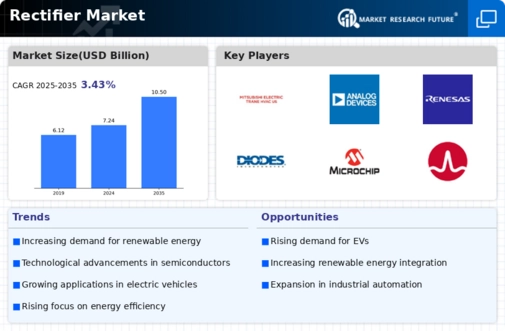Growth in Consumer Electronics
The proliferation of consumer electronics is a notable driver for the Rectifier Market. As households increasingly adopt smart devices, the demand for efficient power conversion solutions rises. Rectifiers are crucial in powering various consumer electronics, from smartphones to home appliances. The consumer electronics market is projected to grow significantly, with estimates suggesting a CAGR of approximately 6 percent over the next few years. This growth is likely to enhance the demand for rectifiers, as manufacturers seek to improve energy efficiency and performance in their products. The Rectifier Market stands to benefit from this trend, as the integration of rectifiers in consumer electronics becomes more prevalent.
Advancements in Power Electronics
Technological advancements in power electronics are shaping the future of the Rectifier Market. Innovations in semiconductor materials and circuit design are leading to more efficient and compact rectifiers. These advancements enable higher performance in power conversion applications, which is crucial for various sectors, including telecommunications and renewable energy. The market for power electronics is expected to witness substantial growth, with projections indicating a CAGR of around 7 percent in the coming years. This growth is likely to drive the demand for advanced rectifiers, as industries seek to enhance energy efficiency and reduce operational costs. The Rectifier Market is thus positioned to capitalize on these technological advancements, fostering further innovation and development.
Electrification of Transportation
The electrification of transportation is emerging as a pivotal driver for the Rectifier Market. With the global shift towards electric vehicles (EVs), the need for efficient power conversion systems is paramount. Rectifiers are integral in charging stations, converting AC power from the grid into DC power for EV batteries. The International Energy Agency indicates that the number of electric cars on the road is expected to reach 145 million by 2030. This surge in electric vehicle adoption is likely to create substantial demand for rectifiers, as they are essential for the efficient operation of charging infrastructure. Consequently, the Rectifier Market is poised for growth as the transportation sector undergoes this significant transformation.
Rising Demand for Renewable Energy
The increasing emphasis on renewable energy sources is driving the Rectifier Market. As countries strive to reduce carbon emissions, the integration of solar and wind energy systems has surged. Rectifiers play a crucial role in converting the generated direct current into alternating current, making it usable for various applications. According to recent data, the renewable energy sector is projected to grow at a compound annual growth rate of over 8 percent in the coming years. This growth is likely to enhance the demand for rectifiers, as they are essential components in energy conversion systems. The Rectifier Market is thus positioned to benefit from this trend, as more renewable energy projects are initiated worldwide.
Industrial Automation and Control Systems
The ongoing trend towards industrial automation is significantly influencing the Rectifier Market. As industries adopt advanced automation technologies, the need for reliable power supply systems becomes critical. Rectifiers are essential in converting and regulating power for various automated processes and control systems. The manufacturing sector, in particular, is experiencing a shift towards smart factories, where rectifiers are utilized in robotics and automated machinery. Reports suggest that the industrial automation market is expected to grow at a CAGR of around 10 percent over the next five years. This growth is likely to drive the demand for rectifiers, as they are integral to ensuring the efficiency and reliability of automated systems within the Rectifier Market.























Leave a Comment